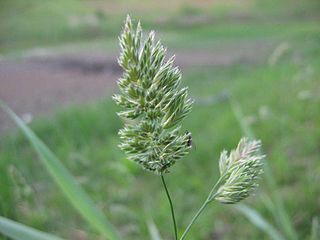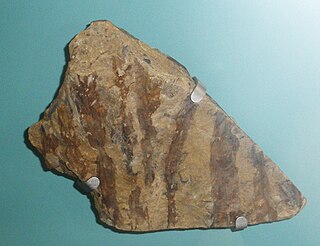
In plant taxonomy, commelinids is a clade of flowering plants within the monocots, distinguished by having cell walls containing ferulic acid.

Drepanophycus is a genus of extinct plants of the Division Lycopodiophyta of Early to Late Devonian age, found in Eastern Canada and Northeast US, China, Russia, Egypt and various parts of Northern Europe and Britain.

Prototaxites is a genus of terrestrial fossil fungi dating from the Middle Ordovician until the Late Devonian periods, approximately 470 to 360 million years ago. Prototaxites formed small to large trunk-like structures up to 1 metre (3 ft) wide, reaching 8 metres (26 ft) in height, made up of interwoven tubes around 50 micrometres (0.0020 in) in diameter, making it by far the largest land-dwelling organism of its time.

Nematothallus is a form genus comprising cuticle-like fossils. Some of its constituents likely represent red algae, whereas others resemble lichens.

Cosmochlaina is a form genus of nematophyte – an early plant known only from fossil cuticles, often found in association with tubular structures. The form genus was put forwards by Dianne Edwards, and is diagnosed by inwards-pointing flanges and randomly oriented pseudo-cellular units. Projections on the outer surface are always present, and sometimes also appear on the inner surface; however, the surface of the cuticle itself is always smooth. The holes in the cuticle are often covered by round flaps, loosely attached along a side.

The Nematophyta or nematophytes are a paraphyletic group of land organisms, probably including some plants as well as algae known only from the fossil record, from the Silurian period until the early Devonian Rhynie chert. The type genus Nematothallus, which typifies the group, was first described by Lang in 1937, who envisioned it being a thallose plant with tubular features and sporophytes, covered by a cuticle which preserved impressions of the underlying cells. He had found abundant disaggregated remains of all three features, none of which were connected to another, leaving his reconstruction of the phytodebris as parts of a single organism highly conjectural. No reproductive or vegetative structures common to the land plants are known, and certain members of the nematophyte plexus seem to belong to the fungi.
Ornatifilum is an artificial form genus, which is used to categorise any small, branched filaments with external ornamentation.

Rhynia is a single-species genus of Devonian vascular plants. Rhynia gwynne-vaughanii was the sporophyte generation of a vascular, axial, free-sporing diplohaplontic embryophytic land plant of the Early Devonian that had anatomical features more advanced than those of the bryophytes. Rhynia gwynne-vaughanii was a member of a sister group to all other eutracheophytes, including modern vascular plants.
Professor Dianne Edwards CBE, FRS, FRSE, FLS, FLSW is a palaeobotanist, who studies the colonisation of land by plants, and early land plant interactions.
Nematoplexus rhyniensis is a fossil known from the Rhynie chert assigned to the nematophytes. It comprises a loose mass of coily aseptate tubes. Tubes which may have originated from a Nematoplexus-like plant are known from earlier Silurian sediments.
Cambrorhytium is an enigmatic fossil genus known from the Latham Shale (California), and the Chengjiang (China) and Burgess Shale lagerstätte. 350 specimens of Cambrorhytium are known from the Greater Phyllopod bed, where they comprise 0.7% of the community.
Steganotheca is a genus of bushy, probably vascular plants with branched axes, known from upper Silurian strata. It has terminal sporangia and reached 5 cm in height.

Banded tubes are a type of phytoclast consisting of micrometre-scale tubes with a banded internal ornamentation, and known from terrestrial/freshwater settings from the Early Silurian onwards.
Uskiella is a genus of small fossil plants of Early Devonian age. The diagnostic characters are naked axes branching isotomously, terminating in ellipsoidal, vertically elongate flat sporangia which split longitudinally into two valves. Spores of U. reticulata have a reticulate appearance. Coalified specimens have been reported from Wales, with a possible occurrence in Australia.
Anthony Ricardo Fiorillo is a senior fellow at the Institute for the Study of Earth and Man at Southern Methodist University, but for many years he was vice president of research & collections and chief curator at the Perot Museum of Nature & Science. A native of Connecticut, he received his bachelor's at the University of Connecticut, his master's at the University of Nebraska and a Ph.D. in Vertebrate Paleontology from the University of Pennsylvania.
Grisellatheca was a genus of land plant with branching axes. It is known from charcoalified Early Devonian deposits, its type locality being the Brown Clee Hill lagerstatten. Its Terahedraletes spores form permanent tetrads.
Fusitheca was a genus of land plant with branching axes. It is known from charcoalified Early Devonian deposits, its type locality being the Brown Clee Hill lagerstätten. Its spores form smooth-walled, unfused, naked dyads. Its axis comprises length-parallel filaments, and their dichotomies are T-shaped, with the branches bending to continue upwards.
Culullitheca was a genus of land plant with branching axes. It is known from charcoalified Early Devonian deposits, its type locality being the Brown Clee Hill lagerstätten. Its spores formed permanent dyads.
Tortotubus is an early terrestrial fungus. Its growth trajectory can be ascertained from its fossils, which occur across the globe from the Ordovician to the Devonian. These fossils document foraging activities of slender, cell-wide exploratory hyphae; when these hit a source of food, they produced secondary branches that grew back down the original filament, covered themselves with an envelope, and served as pipes to shuttle nutrients to other parts of the organism. Today, mycelium with this growth pattern is observed in the mushroom-forming fungi.
Sergio Archangelsky is an Argentine paleobotanist and palynologist. He is a pioneer of modern paleobotany in Argentina, as well as of cuticular morphology and ultrastructure. He is also a corresponding member of the Argentine Academy of Science.






